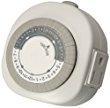The Parenting Code Blog
Raise Amazing Kids
Simple Money Saving – Vampire Appliances
Here’s something you can do to save money in your house while also teaching your kids a valuable lesson about conserving, saving, and taking action.
For a while now I have been thinking about the energy that all of my various electronic appliances use when they are plugged in. These appliances are called Vampire Appliances because, even when you are not using them, they draw energy.
If you weren’t yet aware of this, it’s time to get aware. The list of devices that uses energy when “off” is huge. TVs, stereo equipment, computers, DVD players, video game units, printers, fax machines, PVRs and set top boxes, garage door openers, and much more.
Here is a great FAQ and a table of power consumption by device type.
The simple math you need to know:
For every 1 Watt of “standby power” that a device draws, it will cost you about $1 per year. This stuff ads up fast! I looked at the list and realized that my various gadgets are probably drawing several HUNDRED Watts of power unnecessarily, most of the time. That’s a lot of wasted money.
So here’s what I think is a good actionable “job” you can give your kids. Have them go around the house and identify everything that is plugged in. Everything. Mark it all down.
Then make a list and figure out what needs to be plugged in and what really doesn’t need to be plugged in. Simply unplug things that aren’t used often enough to justify leaving them plugged in.

Then make a list of devices that DO need to be plugged in but probably could be unplugged at night. For those appliances, consider buying a simple mechanical timer like the one in the picture here. These tiny timers cost about $6-8 at my local hardware store and they can be set so they go on and off at whatever time you like. My advice is to use these on the appliances in your house that you use every day, but they consume lots of standby power while they are unused at night. Just set the timer to go on and off at whatever time you like.
Consider this simple example: I have a sub-woofer on my basement home theatre. The table I referenced above tells me that this thing costs me $10 per year to operate. Plugged into the same outlet is my surround sound receiver. I usually leave it ON, and I hadn’t really thought it was costing me much because, although it’s on, it isn’t actually amplifying any sounds. Well, that looks like it’s costing me $40 per year! I could easily put these on a $6-8 timer that would turn the devices on only for the 3 hours (max) of the day that they get used. The timer pays for itself in a few months, and from that point onward it’s money in the bank.
Another example where I could use one of these timers is my Wi-Fi router and cable modem. Surely they consume quite a bit of energy and are ALWAYS left on. But do I really need to have my Internet connection on (and broadcast throughout my house) in the middle of the night? Likely not.
Maybe I’ll just wrap up with another short story that taught me a HUGE lesson. I had 2 leaky toilets last year. Not big leaks, but the “flapper valve” at the bottom of the toilet tank was letting water drop through (from the tank to the bowl), such that the tanks would start to refill themselves every few minutes. I didn’t think much of these leaks because I was busy with other stuff and I never stopped to do the math on how much water it was wasting.
… That was until we got a surprise water bill. Seriously we got a bill that was about $400 higher than normal. So I started doing the math. I looked at the toilet to see how quickly it was leaking water. Then I calculated how much water per day it equated to. Since I had two toilets in this situation I multiplied by 2. It was horrifying. I was wasting several bathtubs worth of water every day. Ouch! Fixing the problem cost me $12 at the hardware store. New rubber flapper valves. That’s it.
So go around your house and see what you can identify in terms of potential energy and utility cost savings. I think you’ll be surprised with what you find.
Enjoy your children AND your wallet
Chris Thompson
SEE ALSO: This audio lesson will forever change the way you interact with your kids.
